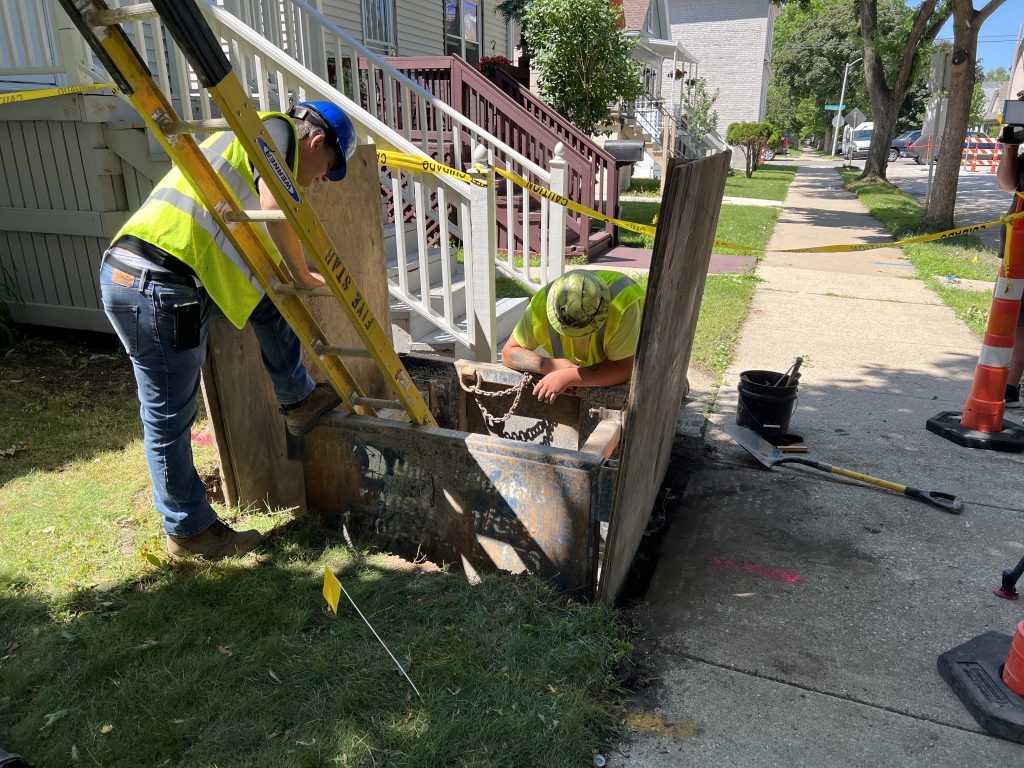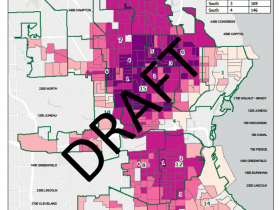Milwaukee Makes It Far Easier To Replace Your Lead Service Line
Opt-in program part of citywide plan to replace all lead service lines in 20 years.

Workers from Five Star Energy Services replace a lead service line on S. 12th St. in 2022. Photo by Jeramey Jannene.
It’s about to get substantially easier to ditch the lead service line that connects your house to the city’s water supply.
The Milwaukee Water Works (MWW) is pursuing a series of programs to replace the approximately 66,000 remaining lead service lines within 20 years, a goal touted by Mayor Cavalier Johnson in his first State of the City address.
Backed by a record infusion of federal funding, the city will need to more than triple its pace of replacements.
Most of that increase will be guided by an algorithm that weighs lead poisoning data and socioeconomic factors to target clusters of homes for no-cost replacements.
But a second, smaller program will allow individual homeowners, regardless of location or income, to request their lead service line be replaced.
“Right now, the owner-initiated process is very cumbersome,” said MWW Superintendent Patrick Pauly to the Public Works Committee on Nov. 29.
Property owners can solicit bids on their own to have the privately-owned portion of the line replaced and then must pay for the work, usually all at once.
“We have heard the cost can be between $6,000 to $8,000 for a property owner to engage a contractor on a one-off basis,” said Pauly. That excludes the cost of the publicly-owned portion, which MWW pays to replace, that connects to the water main.
The new program would have the city manage all of the contracting, and then bill the property owner for the replacement over a period of 15 years.
“I want to change it from being cumbersome to something people want to join in,” said Alderwoman Marina Dimitrijevic, who pushed for the program’s creation. She noted that her district, dominated by Bay View, has the highest concentration of lead service lines in the city, but economic factors make it unlikely to see the targeted, free replacements in the near future.
The alderwoman said concerns from residents she has spoken to have often been about the difficulty of getting the work done, not the cost. “Just taking over the bidding, the contracting, already is an enormous gain,” she said.
The alderwoman said the new program is a “giant change.”
But it comes with one key catch: contractor capacity. Contractors will be focused primarily on the targeted, clustered replacements. MWW will establish a queue of requested properties, directing contractors as they have capacity.
“We will take on as many as we can,” said Department of Public Works Commissioner Jerrel Kruschke.
And even if you have to wait, there is going to be at least one financial incentive to do so.
The city’s average cost, since 2017, to replace the private side of the lateral is $4,800 said Pauly. That’s at least $1,200 less than the cost the superintendent said individuals were negotiating. Regardless of property-specific circumstances, those in the program will only be required to pay the current average price.
Dimitrijevic negotiated for a second financial incentive. The billing will be spread over 15 years and attached to the property tax bill with interest (currently 5.75%). But for the first 100 homeowners, payments will be interest-free for the last eight years.
“The benefit certainly outweighs the cost,” said Dimitrijevic of inducing more optional replacements.
On Dec. 12, the Common Council unanimously endorsed the two new replacement programs. An amendment, introduced by Dimtriejvic, limits the optional replacement program to properties with one to four housing units.
Mandatory Replacements Continue, Challenges Loom
The new programs are an addition to the city’s current replacement programs.
Under the prior city policy, lead services connecting childcare centers to the water supply get replaced for free. Lead service lines that break are replaced with a maximum cost of $1,592 to the property owner. Similarly, if the road in front of a property is reconstructed or a water main is replaced, the lateral gets replaced under the $1,592 cost-sharing formula.
The changes endorsed by the council eliminate the cost share on mandatory replacements, replacing it with federal funding.
But mandatory replacements only add up to slightly more than 1,000 replacements per year. MWW replaced 991 service lines in 2022, 558 because of a leak or failure, 77 at a childcare facility or school, 152 because of water main replacements, 174 because of other infrastructure projects and 30 that were owner-initiated.
Hitting the 20-year goal would require reaching a pace of 3,500 replacements per year. It hopes to ramp up to the goal by 2026.
Pauly, during the November meeting, revealed that MWW is hiring national engineering and consulting firm CDM Smith (not to be confused with Wisconsin general contractor CD Smith) to serve as the owner’s representative on the expanded program. A request for proposals was issued earlier this year.
“They are quite honestly the global leader in lead service line replacements,” said Pauly. The company is also working with the City of Chicago and previously led the replacement of all service lines in Newark, NJ. “They put forward a very solid presentation. They have significant expertise… customer outreach is going to be so very important.”
Kruschke and Pauly said scaling to 3,500 replacements per year wouldn’t be easy. Before the influx of federal funding, Denver undertook an aggressive 15-year replacement plan for a service line inventory similar to Milwaukee’s. The Colorado city replaced 5,119 lines in 2022, but not solely with local contractors. In 2021, then-MWW superintendent Karen Dettmer publicly warned that Denver’s program was hiring away Milwaukee contractors.
The final replacement prioritization algorithm weighs three different datasets measuring U.S. Census Bureau-defined census block groups (which have a population of between 600 to 3,000): a UW-Madison-developed Area Deprivation Index of socioeconomic factors (70%); incidences of children testing positive for blood-lead levels of at least 5 micrograms per deciliter (25%); and lead service line density (5%).
Does Your House Have A Lead Service Line?
Any house built before 1978, which accounts for most in the city, is likely to include lead paint. The last lead service line in the city was believed to be installed in 1962. Interior plumbing, beyond the service line, is also likely to include lead. City officials have repeatedly insisted that lead paint is the biggest danger in homes, but that no amount of lead is safe. Individuals concerned about lead poisoning can learn more about lead-safe filters and testing on the MWW website. MWW also maintains a database of properties with known lead service lines.
Draft Prioritization Map
Legislation Link - Urban Milwaukee members see direct links to legislation mentioned in this article. Join today
If you think stories like this are important, become a member of Urban Milwaukee and help support real, independent journalism. Plus you get some cool added benefits.
Related Legislation: File 231032
More about the Lead Crisis
- Gov. Evers Approves Bill to Support Lead Service Line Replacement in Superior - Gov. Tony Evers - Jul 1st, 2025
- MPS’s Westside Academy Cleared of Lead Risks After Stabilization Work - Milwaukee Public Schools - Jul 1st, 2025
- MPS Plans Lead Remediation at 40 Schools This Summer - Evan Casey - Jun 27th, 2025
- Baldwin, Reed Demand Written Answers from RFK, Jr. on Firings of Childhood Lead Poisoning Experts at CDC - U.S. Sen. Tammy Baldwin - Jun 11th, 2025
- MPS’s LaFollette School Cleared of Lead Risks After Stabilization Work - Milwaukee Public Schools - Jun 11th, 2025
- Sen. Baldwin Hears From Parents About MPS Lead Crisis, Chides RFK Jr. - Evan Casey - Jun 9th, 2025
- Reps. Margaret Arney and Darrin Madison Urge Joint Finance Committee to Reinstate Essential Lead Abatement Funding - State Rep. Margaret Arney - Jun 5th, 2025
- Gov. Evers, DHS Continue Administration’s Efforts to Combat Lead Poisoning Statewide with Permanent Rule - Gov. Tony Evers - May 27th, 2025
- RFK Jr. Claims ‘Team’ Is In Milwaukee Helping With Lead Crisis, Health Department Can’t Find Them - Nick Rommel - May 22nd, 2025
- MPS Announces Starms Early Childhood Center Is Cleared of Lead Dangers - Milwaukee Public Schools - May 21st, 2025
Read more about Lead Crisis here
Political Contributions Tracker
Displaying political contributions between people mentioned in this story. Learn more.
























